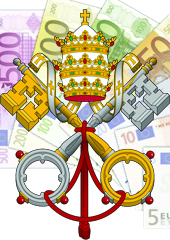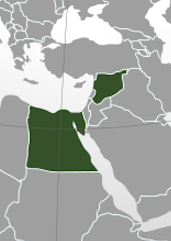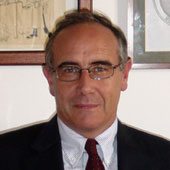Cleaning Up the Vatican Bank
Will Pope Francis be able to complete the reform of the Vatican Bank?
June 26, 2013

The Roman Catholic Church sees itself as destined to judge and to take confession from the world.
In the past, its moral leadership was undisputed, at least in theory.
But in the last ten years or so, its image has been shattered by scandals — both sexual and financial.
The Vatican’s financial operations are conducted by Istituto per le Opere di Religione (IOR) or the Institute for the Works of Religion, known as “the Bank of the Vatican.”
The IOR’s original goal was to collect the money of the Catholic faithful from all over the world.
The “bank,” with its approximately 33,000 clients, mainly priests, nuns, cardinals and “Gentlemen of His Holiness,” is small, even though they are noble, distinguished and sometimes much talked-about people.
De facto, it became something quite different and controversial: a dubious banking operation embedded in the very heart of papal Rome.
Pious people used it for charitable purposes but, increasingly, unscrupulous and anonymous entities used it for other purposes.
It recently got a new president, German lawyer and banker Ernst von Freyberg.
It was about time. There had been nine months of disappointing delay due to the difficulties to find a new one.
The institution’s former head, Ettore Gotti Tedeschi, had been fired in May 2012 after a bitter struggle inside the board of the IOR about three fundamental issues.
These were the rules against money laundering, the reform of the bank and its overall approach to business in a globalized financial world.
The efforts to remake the IOR at the financial level mirror the other efforts that the Vatican State is making to achieve global confidence and reliability.
They also demonstrate the difficulty of getting rid of both old and new suspicions concerning the way in which the IOR has been accused of operating opaquely in the world banking system.
In the past, the typical path followed by the Vatican was to reach an agreement with a single state and to regulate the relations bilaterally. This would apply to any level — religious, political, educational or financial.
In recent years, the growth of global institutions and the decline of national power caused the inner circle of the previous pope, Benedict XVI, to opt for a parallel path.
“The Lateran Pacts of the XXI Century,” as they are labeled in papal Rome, are intended to fit the tiny Roman state into the world of financial institutions. The aim is to get acceptance to act in the banking system as a normal actor.
Transparency is necessary for the IOR to clean up its mysterious image. That transformation of the bank was halfway done when then Pope Benedict XVI stepped down.
A dark shadow has loomed over the bank since the tenure of Polish-American Monsignor Paul Marcinkus in the 1980s and it has lasted up to the most recent scandals.
That’s why a different approach had to be put in place. The Vatican had to be examined and judged by lay institutions.
In a way, it had to confess its “financial sins” to people external to its world and it awaits their “acquittal.” It is even risking being rebuffed and pushed back.
Gotti Tedeschi, the economist who ran the IOR from 2009 to May 2012, was viewed as “Mr. Clean.”
He was picked by the then Pope himself and by his Secretary of State, Cardinal Tarcisio Bertone, to renew the image of the “Institute” from the bottom up.
He went about his mission for a couple of years. His efforts involved Moneyval, the monitoring agency which the European Council set up to certify the financial rectitude of nations’ banking operations.
After in-depth and repeated inquiries by its officers, Moneyval receives a report by a state.
Then they decide if it complies with the recommendations on money laundering and financing terrorism.
Admission to Moneyval’s “white list” means a country’s financial institutions are reliable.
If a state doesn’t comply with most of Moneyval’s strategic recommendations, it is suspected of laundering money and even of financing terrorism.
Gotti Tedeschi’s work moved on swimmingly until it treaded on the Vatican’s most secret habits. The economist was considered by his peers on the board too naïve, emotional, non-strategic and not enough in tune with the “unwritten rules” of the bank.
But the suspicion is that, beyond these alleged handicaps, a conflict emerged between a commitment to transparency and the Holy See’s instinct for self-defense to protect its sovereignty.
The price for opening up the standard of international financial institutions collided with the need to preserve its “national security” and to keep the secrecy around some of its financial activities.
Eventually, in June 2012, the IOR received a conditional “yes” from Moneyval.
That decision weakened Gotti Tedeschi’s accusations against the internal structure of the “Vatican Bank.” The banker was viewed as an obstacle, not as a problem-solver in promoting transparency.
What has happened since then and is still happening shows the difficulty in the metamorphosis of this ambiguous institute created to collect money but operating sometimes in a disputable way.
At the beginning of 2013, just after the Christmas holidays, all the “Points of Sale” inside Vatican City were banned by the Italian judiciary from accepting payments with credit cards.
Even in the Vatican Museum, tourists could pay in cash only.
The Bank of Italy made the move, pushed to act by Italian magistrates who since 2009 had been investigating possible wrongdoing by the IOR.
The reason: an unsolved conflict between laws and permissions, with new suspicions about money laundering that were not clarified by the Holy See.
Whether the suspicions were well grounded or not, it was an embarrassing episode. And the new president of the IOR was chosen afterwards among non-Italian candidates just days after the announcement of Pope Benedict’s resignation.
It is the second time a “foreigner” has headed the IOR since its founding by Pope Pius XII in 1942. The first foreign president was Monsignor Marcinkus, not exactly a “Mr. Clean,” to say the least.
The future of the IOR itself is a big question mark over the term of Jorge Maria Bergoglio as Pope Francis.
The question is whether the plan for reform will suffice to allow the globalization of the “Vatican Bank” to go ahead in a convincing and proper way. And it remains to be seen what the outcome will be for IOR’s financial identity.
The next report of Moneyval will be released at the end of 2013.
Pope Francis is eager to reaffirm the image of a “poor Church” devoted to the poor and is attentive to the global trend of “non-state actors” such as megacities with their expanding slums.
It’s quite clear what the new Pope means for reform of the IOR. On April 19, 2013, he abolished the annual fee of 25,000 euros paid to each of the five cardinals in the bank’s supervisory council.
And on May 6, 2013, the Vatican Authority for Financial Information (AIF) signed a memorandum with the U.S. Financial Crimes Enforcement Network for a common battle against money laundering.
For the Pope, offices are necessary “but only to a certain extent,” he said about the IOR.
Honduran cardinal Oscar Rodriguez Maradiaga, one of the eight “wise men” summoned by the Pontiff, said recently that shutting the Institute down “is not the problem. At least, not so far. But a reshaping of it indeed is…”
For Bergoglio, transforming the IOR might prove more challenging than transforming the Church itself.
Read previous

Egypt and Syria: Beyond Repair
June 25, 2013
